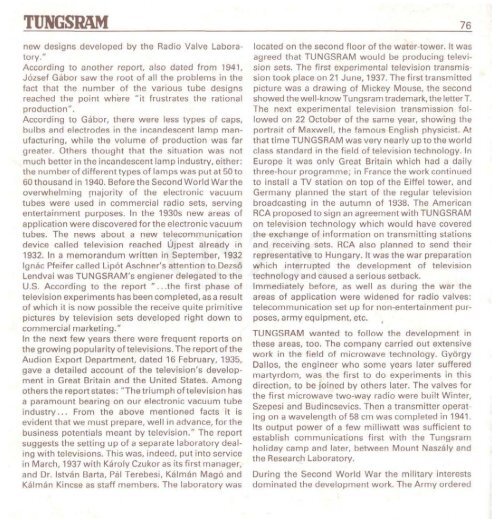THE HISTORY OF TUNGSRAM 1896-1945 - MEK
THE HISTORY OF TUNGSRAM 1896-1945 - MEK
THE HISTORY OF TUNGSRAM 1896-1945 - MEK
- No tags were found...
You also want an ePaper? Increase the reach of your titles
YUMPU automatically turns print PDFs into web optimized ePapers that Google loves.
<strong>TUNGSRAM</strong> 76new designs developed by the Radio Valve Laboratory."According to another report, also dated from 1941,Jozsef Gabor saw the root of all the problems in thefact that the number of the various tube designsreached the point where "it frustrates the rationalproduction".According to Gabor, there were less types of caps,bulbs and electrodes in the incandescent lamp manufacturing,while the volume of production was fargreater. Others thought that the situation was notmuch better in the incandescent lamp industry, either:the number of different types of lamps was put at 50 to60 thousand in 1940. Before the Second World Wartheoverwhelming majority of the electronic vacuumtubes were used in commercial radio sets, servingentertainment purposes. In the 1930s new areas ofapplication were discovered for the electronic vacuumtubes. The news about a new telecommunicationdevice called television reached Ujpest already in1932. In a memorandum written in September, 1932Ignac Pfeifer called Lipot Aschner's attention to DezsoLendvai was <strong>TUNGSRAM</strong>'S engiener delegated to theU.S. According to the report "...the first phase oftelevision experiments has been completed, as a resultof which it is now possible the receive quite primitivepictures by television sets developed right down tocommercial marketing."In the next few years there were frequent reports onthe growing popularity of televisions. The report of theAudion Export Department, dated 16 February, 1935,gave a detailed account of the television's developmentin Great Britain and the United States. Amongothers the report states: "The triumph of television hasa paramount bearing on our electronic vacuum tubeindustry... From the above mentioned facts it isevident that we must prepare, well in advance, for thebusiness potentials meant by television." The reportsuggests the setting up of a separate laboratory dealingwith televisions. This was, indeed, put into servicein March, 1937 with Karoly Czukor as its first manager,and Dr. Istvan Barta, Pal Terebesi, Kalman Mago andKalman Kincse as staff members. The laboratory waslocated on the second floor of the water-tower. It wasagreed that <strong>TUNGSRAM</strong> would be producing televisionsets. The first experimental television transmissiontook place on 21 June, 1937. The first transmittedpicture was a drawing of Mickey Mouse, the secondshowed the well-know Tungsram trademark, the letterT.The next experimental television transmission followedon 22 October of the same year, showing theportrait of Maxwell, the famous English physicist. Atthat time <strong>TUNGSRAM</strong> was very nearly up to the worldclass standard in the field of television technology. InEurope it was only Great Britain which had a dailythree-hour programme; in France the work continuedto install a TV station on top of the Eiffel tower, andGermany planned the start of the regular televisionbroadcasting in the autumn of 1938. The AmericanRCA proposed to sign an agreement with <strong>TUNGSRAM</strong>on television technology which would have coveredthe exchange of information on transmitting stationsand receiving sets. RCA also planned to send theirrepresentative to Hungary. It was the war preparationwhich interrupted the development of televisiontechnology and caused a serious setback.Immediately before, as well as during the war theareas of application were widened for radio valves:telecommunication set up for non-entertainment purposes,army equipment, etc. , '<strong>TUNGSRAM</strong> wanted to follow the development inthese areas, too. The company carried out extensivework in the field of microwave technology. GyorgyDallos, the engineer who some years later sufferedmartyrdom, was the first to do experiments in thisdirection, to be joined by others later. The valves forthe first microwave two-way radio were built Winter,Szepesi and Budincsevics. Then a transmitter operatingon a wavelength of 58 cm was completed in 1941.Its output power of a few milliwatt was sufficient toestablish communications first with the Tungsramholiday camp and later, between Mount Naszaly andthe Research Laboratory.During the Second World War the military interestsdominated the development work. The Army ordered• . .. \








![Letöltés egy fájlban [4.3 MB - PDF]](https://img.yumpu.com/50159926/1/180x260/letaltacs-egy-fajlban-43-mb-pdf.jpg?quality=85)







